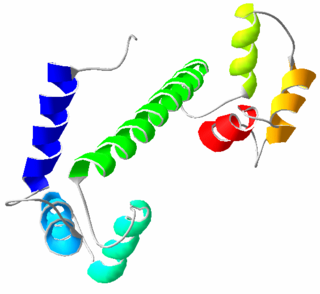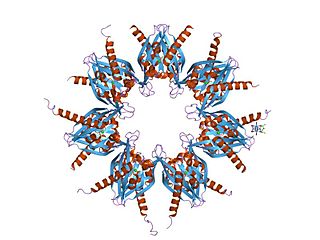Related Research Articles

Calmodulin (CaM) (an abbreviation for calcium-modulated protein) is a multifunctional intermediate calcium-binding messenger protein expressed in all eukaryotic cells. It is an intracellular target of the secondary messenger Ca2+, and the binding of Ca2+ is required for the activation of calmodulin. Once bound to Ca2+, calmodulin acts as part of a calcium signal transduction pathway by modifying its interactions with various target proteins such as kinases or phosphatases.

A dendritic spine is a small membranous protrusion from a neuron's dendrite that typically receives input from a single axon at the synapse. Dendritic spines serve as a storage site for synaptic strength and help transmit electrical signals to the neuron's cell body. Most spines have a bulbous head, and a thin neck that connects the head of the spine to the shaft of the dendrite. The dendrites of a single neuron can contain hundreds to thousands of spines. In addition to spines providing an anatomical substrate for memory storage and synaptic transmission, they may also serve to increase the number of possible contacts between neurons. It has also been suggested that changes in the activity of neurons have a positive effect on spine morphology.

In neuroscience, long-term potentiation (LTP) is a persistent strengthening of synapses based on recent patterns of activity. These are patterns of synaptic activity that produce a long-lasting increase in signal transmission between two neurons. The opposite of LTP is long-term depression, which produces a long-lasting decrease in synaptic strength.
In neurophysiology, long-term depression (LTD) is an activity-dependent reduction in the efficacy of neuronal synapses lasting hours or longer following a long patterned stimulus. LTD occurs in many areas of the CNS with varying mechanisms depending upon brain region and developmental progress.
In neuroscience, a silent synapse is an excitatory glutamatergic synapse whose postsynaptic membrane contains NMDA-type glutamate receptors but no AMPA-type glutamate receptors. These synapses are named "silent" because normal AMPA receptor-mediated signaling is not present, rendering the synapse inactive under typical conditions. Silent synapses are typically considered to be immature glutamatergic synapses. As the brain matures, the relative number of silent synapses decreases. However, recent research on hippocampal silent synapses shows that while they may indeed be a developmental landmark in the formation of a synapse, that synapses can be "silenced" by activity, even once they have acquired AMPA receptors. Thus, silence may be a state that synapses can visit many times during their lifetimes.

Brain-derived neurotrophic factor (BDNF), or abrineurin, is a protein that, in humans, is encoded by the BDNF gene. BDNF is a member of the neurotrophin family of growth factors, which are related to the canonical nerve growth factor (NGF), a family which also includes NT-3 and NT-4/NT-5. Neurotrophic factors are found in the brain and the periphery. BDNF was first isolated from a pig brain in 1982 by Yves-Alain Barde and Hans Thoenen.

CREB-TF is a cellular transcription factor. It binds to certain DNA sequences called cAMP response elements (CRE), thereby increasing or decreasing the transcription of the genes. CREB was first described in 1987 as a cAMP-responsive transcription factor regulating the somatostatin gene.

A place cell is a kind of pyramidal neuron in the hippocampus that becomes active when an animal enters a particular place in its environment, which is known as the place field. Place cells are thought to act collectively as a cognitive representation of a specific location in space, known as a cognitive map. Place cells work with other types of neurons in the hippocampus and surrounding regions to perform this kind of spatial processing. They have been found in a variety of animals, including rodents, bats, monkeys and humans.

Susumu Tonegawa is a Japanese scientist who was the sole recipient of the Nobel Prize for Physiology or Medicine in 1987 for his discovery of V(D)J recombination, the genetic mechanism which produces antibody diversity. Although he won the Nobel Prize for his work in immunology, Tonegawa is a molecular biologist by training and he again changed fields following his Nobel Prize win; he now studies neuroscience, examining the molecular, cellular and neuronal basis of memory formation and retrieval.
The endocannabinoid system (ECS) is a biological system composed of endocannabinoids, which are endogenous lipid-based retrograde neurotransmitters that bind to cannabinoid receptors (CBRs), and cannabinoid receptor proteins that are expressed throughout the vertebrate central nervous system and peripheral nervous system. The endocannabinoid system remains under preliminary research, but may be involved in regulating physiological and cognitive processes, including fertility, pregnancy, pre- and postnatal development, various activity of immune system, appetite, pain-sensation, mood, and memory, and in mediating the pharmacological effects of cannabis. The ECS plays an important role in multiple aspects of neural functions, including the control of movement and motor coordination, learning and memory, emotion and motivation, addictive-like behavior and pain modulation, among others.

Ca2+
/calmodulin-dependent protein kinase II is a serine/threonine-specific protein kinase that is regulated by the Ca2+
/calmodulin complex. CaMKII is involved in many signaling cascades and is thought to be an important mediator of learning and memory. CaMKII is also necessary for Ca2+
homeostasis and reuptake in cardiomyocytes, chloride transport in epithelia, positive T-cell selection, and CD8 T-cell activation.
Denise Manahan-Vaughan is an Irish neuroscientist and neurophysiologist. She is head of the Department of Neurophysiology, dean of studies and director of the International Graduate School of Neuroscience and co-founder of the Research Department of Neuroscience of the Ruhr University Bochum. Her research focuses on elucidation of the cellular and synaptic mechanisms underlying the acquisition and long-term maintenance of associative memories. She uses a multidisciplinary approach to study how spatial experiences, sensory input, neuromodulation, or brain disease impacts on, and provide insight into, the function of the hippocampus in enabling long-term memory.

Protein kinase C, zeta (PKCζ), also known as PRKCZ, is a protein in humans that is encoded by the PRKCZ gene. The PRKCZ gene encodes at least two alternative transcripts, the full-length PKCζ and an N-terminal truncated form PKMζ. PKMζ is thought to be responsible for maintaining long-term memories in the brain. The importance of PKCζ in the creation and maintenance of long-term potentiation was first described by Todd Sacktor and his colleagues at the SUNY Downstate Medical Center in 1993.

Calcium/calmodulin-dependent protein kinase type II subunit alpha (CAMKIIα), a.k.a.Ca2+/calmodulin-dependent protein kinase II alpha, is one subunit of CamKII, a protein kinase (i.e., an enzyme which phosphorylates proteins) that in humans is encoded by the CAMK2A gene.

Glutamate [NMDA] receptor subunit epsilon-1 is a protein that in humans is encoded by the GRIN2A gene. With 1464 amino acids, the canonical GluN2A subunit isoform is large. GluN2A-short isoforms specific to primates can be produced by alternative splicing and contain 1281 amino acids.

Alcino J. Silva is a Portuguese-American neuroscientist who was the recipient of the 2008 Order of Prince Henry and elected as a fellow of the American Association for the Advancement of Science in 2013 for his contributions to the molecular cellular cognition of memory, a field he pioneered with the publication of two articles in Science in 1992.
Eric Klann is an American neuroscientist who studies how molecular signaling, synaptic plasticity, and behavior are altered in developmental disability, autism, aging, psychiatric disorders, and Alzheimer's disease.

Min Zhuo is a pain neuroscientist at the University of Toronto in Canada. He is the Michael Smith Chair in Neuroscience and Mental Health as well as the Canada Research Chair in Pain and Cognition and a Fellow of the Royal Society of Canada. Zhou was hosted in 2017-2018 as a guest professor at the pharmacology institute at Heidelberg University, Heidelberg.
Rishikesh Narayanan is an Indian neuroscientist, computer engineer and a professor at the Molecular Biophysics Unit (MBU) of the Indian Institute of Science. He is the principal investigator at the Cellular Neurophysiology Laboratory of MBU where his team is engaged in researches on experimental and theoretical aspects of information processing in single neurons and their networks. The Council of Scientific and Industrial Research, the apex agency of the Government of India for scientific research, awarded him the Shanti Swarup Bhatnagar Prize for Science and Technology, one of the highest Indian science awards, in 2016, for his contributions to biological sciences.
Early long-term potentiation (E-LTP) is the first phase of long-term potentiation (LTP), a well-studied form of synaptic plasticity, and consists of an increase in synaptic strength. LTP could be produced by repetitive stimulation of the presynaptic terminals, and it is believed to play a role in memory function in the hippocampus, amygdala and other cortical brain structures in mammals.
References
- ↑ Morris RG, Anderson E, Lynch GS, Baudry M (1986). "Selective impairment of learning and blockade of long-term potentiation by an N-methyl-D-aspartate receptor antagonist, AP5". Nature. 319 (6056): 774–6. Bibcode:1986Natur.319..774M. doi:10.1038/319774a0. PMID 2869411. S2CID 4356601.
- ↑ Silva AJ, Paylor R, Wehner JM, Tonegawa S (1992). "Impaired spatial learning in alpha-calcium-calmodulin kinase II mutant mice". Science. 257 (5067): 206–11. Bibcode:1992Sci...257..206S. doi:10.1126/science.1321493. PMID 1321493.
- ↑ Silva AJ, Stevens CF, Tonegawa S, Wang Y (1992). "Deficient hippocampal long-term potentiation in alpha-calcium-calmodulin kinase II mutant mice". Science. 257 (5067): 201–6. Bibcode:1992Sci...257..201S. doi:10.1126/science.1378648. PMID 1378648.
- ↑ Grant SG, O'Dell TJ, Karl KA, Stein PL, Soriano P, Kandel ER (1992). "Impaired long-term potentiation, spatial learning, and hippocampal development in fyn mutant mice". Science. 258 (5090): 1903–10. Bibcode:1992Sci...258.1903G. doi:10.1126/science.1361685. PMID 1361685. S2CID 21065410.
- ↑ Silva AJ (2003). "Molecular and cellular cognitive studies of the role of synaptic plasticity in memory". J. Neurobiol. 54 (1): 224–37. doi: 10.1002/neu.10169 . PMID 12486706.
